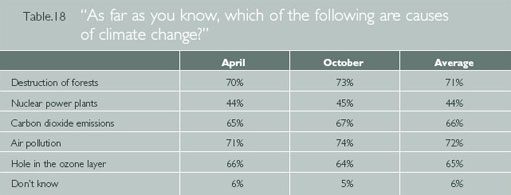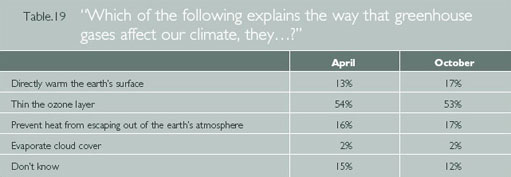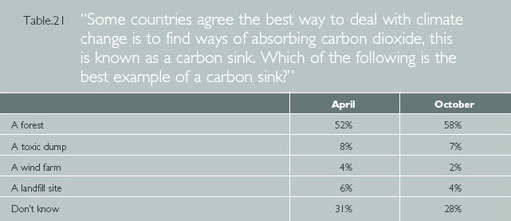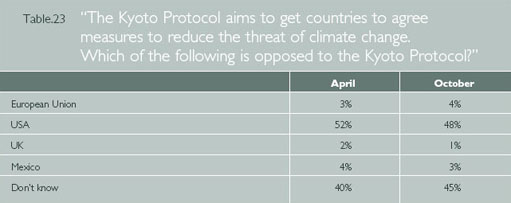10.7 The media and public understanding of climate change
Hargreaves, I., Lewis, J. and Speers, T. ‘Towards a better map: Science, the public and the media’, Economic and Social Research Council.
Our analysis of media coverage suggested that this was an issue that received more attention in the broadsheets than the tabloids, with The Guardian and The Sun/News of the World being at the two ends of the spectrum. It is notable, then, that in the October Survey 83 per cent of Guardian/Independent readers felt that climate change ‘was something we should be concerned about’, compared with only 55 percent of Sun readers. A significant proportion of readers would therefore appear to be following their newspaper's lead in their levels of concern, or else have selected a newspaper in line with their own preoccupations.
More profound, perhaps, is the way media content is generally reflected in the public understanding of climate change. In short, people are aware of the issue, and most people are able to link climate change to the destruction of forests and carbon dioxide emissions. But few people can explain the process behind this link, and as a consequence, see climate change as a consequence of a whole hotch potch of environmentally sensitive issues. Whether this matters or not, in terms of people's ability to contribute to discussions about the climate change, is an issue we shall take up later. Our concern at this point is the way in which media coverage is reflected in public understanding.
As we have seen, media coverage does pay attention to the proposed causes of climate change (55 per cent of stories make some reference to the causes), but only in cursory way. So while greenhouse gases are mentioned in four out of ten newspaper articles, the greenhouse effect itself is rarely explained. It is perhaps not surprising then, that confronted with a list of possible causes, most people tend to respond with a rather cavalier list. Most of the issues on this list are matters of environmental concern, but some have little to do with climate change (see also Bell 1991: 239, for a discussion of knowledge of the causes of climate change).
On the surface, the number of people who see the hole in the ozone layer or nuclear power plants as causes of climate change is difficult to explain: this is not, after all, a claim made in media coverage. But the fact that so many people make these links tells us something about the way people learn from the media.
Other research on the relationship between news and public understanding suggests that most people consume news rather inadvertently, and hence only take in certain aspects of a story. They also find it hard to follow the often truncated narratives of news – which unlike other stories, tends to start with the climax of a story before giving any history or background – and hence a great deal of information passes people by. The information that does stick, in this context, is often based on often repeated associations (Lewis, 1992; 2001). People then use what information they have to make sense of the world – what has been called ‘low information rationality’ (Sniderman, Brody and Tetlock, 1991) or ‘information short-cuts’ (Popkin, 1991).
In the case of climate change, this involves turning associations (between environmental problems like the thinning ozone layer and global warming) into causal links. In the last few years, media reports have often mentioned global warming and the ozone layer in the same breath:
“A new satellite which will provide scientists with a kind of health check forthe earth was launched today. The satellite, costing £1 and half billion, will orbit earth forthe next 5 years studying things like the hole in the ozone layer and global warming” (ITV News, 1st March, 2002).
“WHEN British engineers pioneered the industrial revolution and the world's first great factories 200 years ago, their eye was on progress and profit – not pollution. But scientists now believe it put us on a collision course with nature, which will see the destruction of many aspects of life on earth. Hundreds of millions of cars now spew out poisonous gases. Cities belch smoke up into the ozone layer, while distant conferences sit and discuss what to do about it. At the heart of the debate is the effect of ‘global warming’ and the ‘greenhouse effect’, caused by us producing too much carbon dioxide from burning fossil fuels. If addressed quickly enough, we might start to slow the process of the planet getting hotter” (The Daily Mirror, 29th March, 2002).
Neither of these examples assert a causal connection, and yet in the absence of any other explanation offered, most people tend to assume one. This is suggested more clearly by the response to a question asked in both surveys about the greenhouse effect. The erroneous idea that greenhouse gases effect the climate by thinning the ozone layer outnumbers correctly responses (they ‘prevent heat from escaping out of the earth's atmosphere’) by more than three to one. Bell also found that people often attributed rising temperatures to ozone depletion, which he describes as a ‘classic case of meltdown between events with similar mental scripts’ (1991: 245).
While those with more science education were more likely to get the answer right, the figure still rises to only 24 per cent for those with a formal qualification in science (GCSE or above). And the percentage of correct responses overall is notably lower than the 25 per cent who claimed to be ‘well informed’ about this issue.
One could argue that ignorance of the technicalities here are less important than a more holistic understanding of the environment. Thus, for example, one could argue that people are right to understand the thinning ozone layer and the greenhouse effect as linked, in the sense they are both environmental problems caused by industrialisation and human Activity. We shall return to this issue in our Conclusion: for the time being, what interests us about these responses is what they reveal about way media coverage (whether it means to or not) creates explanatory frameworks.
Interestingly, the age group most likely to get this particular question right was the one with the lowest scores overall – the 18–25 year olds. Those in this age group with more education did particularly well, 22 per cent those with A-Levels and 37 per cent of those with a degree answering correctly. This suggests that schools have recently included a scientific explanation of global warming in their teaching, with a considerable degree of success.
General lack of certainty about the causes of global warming is also reflected in the difficulty people have in connecting the local with the global, thereby understanding how the daily choices in their own lives might be linked to climate change. So, for example, although a number of stories linked global warming to the phrase ‘fossil fuels’, few explained what this meant, and less than two per cent of the articles mentioning climate change in our study made any reference to how the public might contribute to reducing the rate of climate change.
A rare attempt in our sample to deal with this type of issue is made by The Observer's travel editor Jeannette Hyde, as follows:
“one seat on a flight from the UK to the US is responsible for as much global warming from carbon dioxide emissions as one average driver using a car in the UK for a year” (17th April, 2002).
While it is very difficult to be definitive about environmental impacts, many climate change scientists have argued that flying goods around the world tends to involve the burning of more fossil fuels than buying local produce, thereby contributing to climate change. Since this is a good example of how people's everyday choices may have an impact on the issue, as well as one which reveals a degree of understanding of what fossil fuels are, we asked people in our surveys to make such a choice.
The word ‘organic’ is undoubtedly a source of confusion in this respect, since it is generally associated with environmentalism, suggesting, once again, that for around a quarter of our sample, associations may be standing in for causal relationships2. The answers do suggest, nonetheless, that more people (more than four in ten) were aware enough of the role of fossil fuels to make the hypothetical choice for local produce.
In some instances, ‘low information rationality’ does push a majority towards the correct response. The concept of a ‘carbon sink’ may have been familiar to a minority following post-Kyoto negotiations between the US and Europe, but it is not a term widely used in media coverage. Nonetheless, there was enough information in the following question for most people to work out what it meant.
Since the association between deforestation and climate change is already well established (partly by long-running campaigns to save rain forests), ‘forests’ become the most plausible response for a majority of respondents.
Our news study also suggested that the news media pays considerable attention to the consequences of global warming, particularly in the British context. To test how widespread knowledge of these consequences is, we asked a question with a correct response that is, in some ways, counter intuitive. Hence the predicted increase in winter rainfall might seem, for some, to contradict the idea of ‘global warming’ (for British people, wet and cold weather are often seen to go together). Nevertheless, most people in both surveys gave the correct response.
So if the news tends to ignore the processes behind global warming, it appears to be much more instructive in creating an association in people's minds between climate change and increased rainfall. This fits, once again, with news values, in which the dramatic flooding in recent years has been linked with climate change.
Climate change has become a major international political issue in recent years, and the surveys included a question to examine whether one of the main points of conflict in international negotiations on climate change is common knowledge.
This is an issue that has received a moderate amount of media coverage, and around half our respondents get it right. Answers here might also be influenced by attitudes to the Bush presidency. What is more notable about this response is the comparative absence of incorrect assumptions. This appears to be one of those areas that people either feel they know or they don't – over 90 per cent of responses are either correct or ‘don't know’. The fact that this is unusual is indicative of the process by which people learn from news: this is one of the few questions that does not involve answers where associations people draw from media coverage might steer them in the wrong direction.
Overall, the relationship between media coverage and public understanding on this issue demonstrates both the media's power to inform and, inadvertently, to misinform. On the one hand, most people have clearly learnt a number of things from the media coverage of this issue, but the way people absorb information from the news means that they are also inclined to mistake thematic links for causal links. This, in turn, has made people concerned about climate change, but much less clear how it works.
2 We are aware that the use of fossil fuels in the production and transportation of pesticides in the production of the non-organic apples may complicate this comparison. While it is possible that those choosing the organic option were making such a calculation, we think it more likely that those who are aware of the role of fossil fuels in global warming would have picked the first option.






